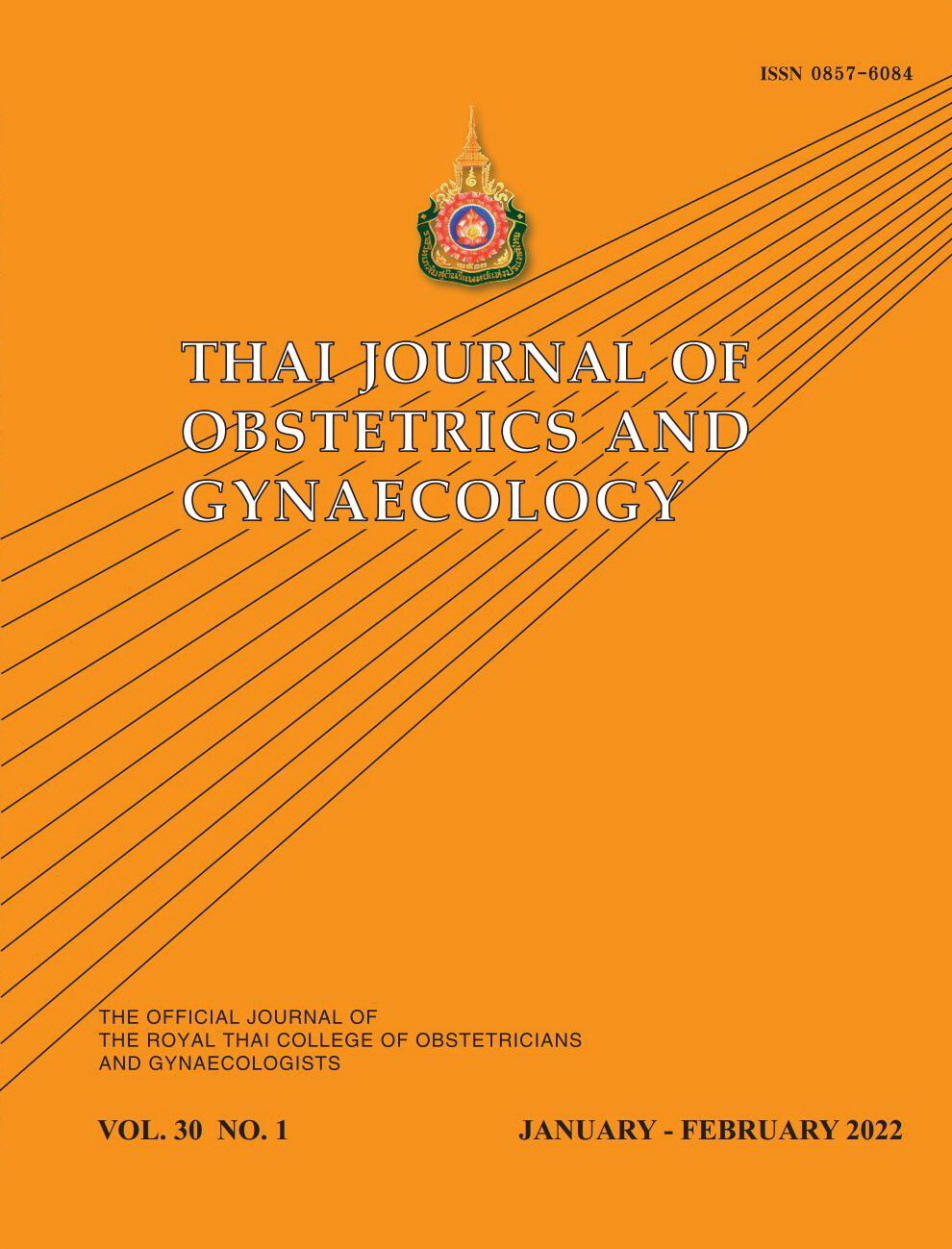Survival Rate of Cervical Cancer Patients According to the 2018 FIGO Staging System: A tertiary hospital based study, Vajira Hospital, Bangkok
Main Article Content
Abstract
Objectives: To validate survival rate of cervical cancer patients based on the revised 2018 International Federation of Gynecology and Obstetrics (FIGO) staging system.
Materials and Methods: Medical records of cervical cancer patients from 2006-2015 were reviewed. The locally-advanced patients without radiological imaging or incomplete medical records were excluded. All included patients were assigned as FIGO 2018 staging criteria.
Results: Of the 226 patients with cervical cancer analyzed. Mean age was 51 ±12 years (17-90 years). Squamous cell carcinoma was the most common cell type in 159 patients (70.4%). According to FIGO 2018 staging criteria, 81 patients (35.8%) were upstaged. The 5-year progression-free survival (PFS) of stage IB1, IB2 and IB3 were 83.3%, 90.0% and 84.2%, respectively and the 5-year overall survivals (OS) were 71.4%, 92.2% and 62.5%, respectively. The PFS and OS were not different among 3 sub-stages. The 5-year PFS of stage IIIB, IIIC1 and IIIC2 were 68.6%, 89.3% and 62.5%, respectively and the 5-year OS were 71.4%, 92.2% and 62.5%, respectively. The PFS and OS of stage IIIB and IIIC2 were not significantly different (p = 0.163 and 0.166, respectively) while survival of stage IIIC1 was significantly higher than stage IIIB (p = 0.025 and 0.017, respectively) and IIIC1 (p = 0.001 and 0.001, respectively).
Conclusion: The revised 2018 FIGO staging system for cervical cancer was useful to distinguish survival rates of patients with locally-advanced disease and distant metastasis while the survival rate of sub-stages of early-stage disease was no different. Stage III disease, para-aortic metastasis was the most impact on the survival rate.
Article Details

This work is licensed under a Creative Commons Attribution-NonCommercial-NoDerivatives 4.0 International License.
References
International Agency for Research on Cancer (2018). Population fact sheets [Internet]. 2018 [cited 2020 Aug 24]. Available from: https://gco.iarc.fr/
Pecorelli S. Revised FIGO staging for carcinoma of the vulva, cervix, and endometrium. Int J Gynaecol Obstet 2009;105:103-4.
Bhatla N, Aoki D, Sharma DN, Sankaranarayanan R. Cancer of the cervix uteri. Int J Gynaecol Obstet 2018;143 Suppl 2:22-36.
Bhatla N, Berek JS, Cuello Fredes M, Denny LA, Grenman S, Karunaratne K,et al. Revised FIGO staging for carcinoma of the cervix uteri. Int J Gynaecol Obstet 2019;145:129-35.
Matsuo K, Machida H, Mandelbaum RS, Konishi I, Mikami M. Validation of the 2018 FIGO cervical cancer staging system. Gynecol Oncol 2019;152:87-93.
Ayhan A, Aslan K, Bulut AN, Akilli H, Öz M, Haberal A, et al. Is the revised 2018 FIGO staging system for cervical cancer more prognostic than the 2009 FIGO staging system for women previously staged as IB disease? Eur J Obstet Gynecol Reprod Biol 2019;240:209-14.
McComas KN, Torgeson AM, Ager BJ, Hellekson C, Burt LM, Maurer KA, et al. The variable impact of positive lymph nodes in cervical cancer: Implications of the new FIGO staging system. Gynecol Oncol 2020;156:85-92.
Yang J, Delara R, Magrina J, Magtibay P, Yi J, Langstraat C, et al. Comparing survival outcomes between surgical and radiographic lymph node assessment in locally advanced cervical cancer: A propensity score-matched analysis. Gynecol Oncol 2020;156:320-7.
Vandeperre A, Van Limbergen E, Leunen K, Moerman P, Amant F, Vergote I. Para-aortic lymph node metastases in locally advanced cervical cancer: Comparison between surgical staging and imaging. Gynecol Oncol 2015;138:299-303.


